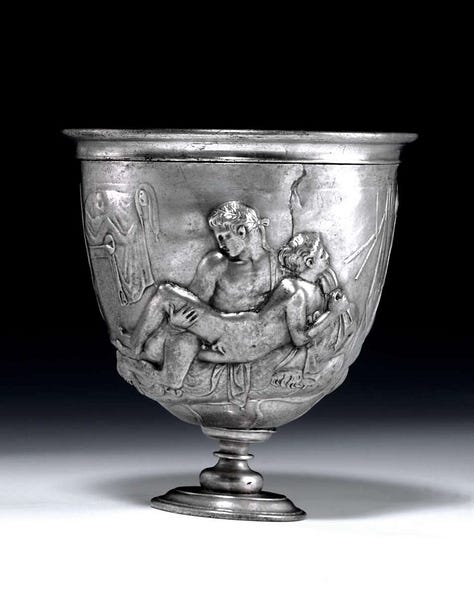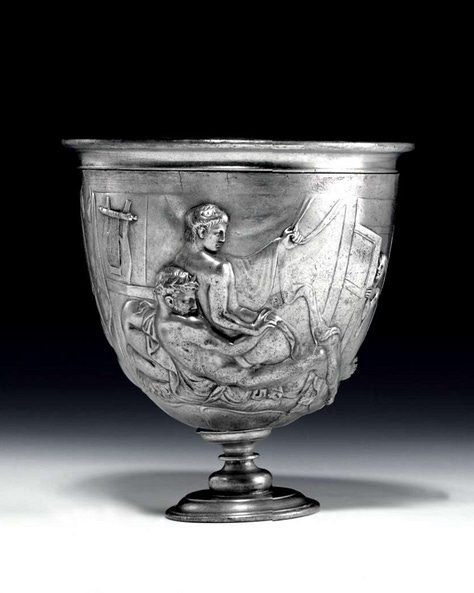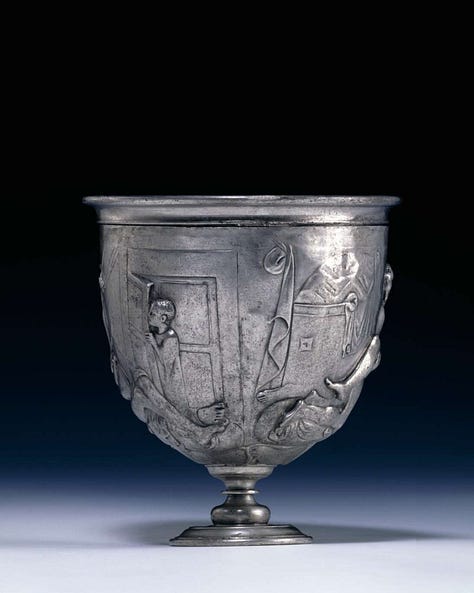The Warren Cup: Ancient Rome’s Homoerotic Masterpiece Uncovered
Explore the explicit imagery, historic controversies, and LGBTQ+ impact of this 2,000-year-old silver treasure.
Unveiling the Warren Cup: Rome’s Raunchy (Yet Refined) Treasure
If you’ve ever thought ancient Rome was all gladiators and togas, get ready to have your mind blown. Meet the Warren Cup, a 2,000-year-old silver drinking vessel that proves the Romans knew how to party — and weren’t shy about showing it. Housed in the British Museum since 1999, this artifact is steeped in history, controversy, and, yes, rather explicit male-on-male erotic scenes. So, pull up a chair and maybe pour yourself a glass of something nice, because it’s about to get juicy.
A Quick History Lesson
First things first: the Warren Cup is named after its most famous owner, Edward Perry Warren, an American collector of classical antiquities with a keen interest in male homoerotic art. He acquired it in the early 20th century, but the cup itself is believed to date back to the 1st century CE. When Warren tried to bring the cup to the United States, customs officials freaked out over its explicit imagery. (Imagine your grandma’s face if you tried to gift-wrap this for her mantel.)
For years, the cup stayed in private hands, occasionally glimpsed in scholarly circles but largely kept away from public view to avoid scandal. Then, in 1999, the British Museum scooped it up for a whopping £1.8 million. Today, it’s one of the museum’s star attractions — and one of the most talked-about pieces in its entire Roman collection.
A Detailed Look at the Warren Cup
Physically, the Warren Cup stands around 10 centimeters (4 inches) high and measures about 9.5 centimeters (3.7 inches) in diameter, crafted with high-quality silver that was likely hammered and shaped by skilled Roman artisans in the 1st century CE. It features a single handle, though its design suggests it could have been part of a larger set, used in an elite Roman household for wine or other beverages.
What really sets the Warren Cup apart is the intricate high-relief decoration around the exterior. The relief is so finely executed that every fold of cloth, every strand of hair, and every muscle contour is rendered in stunning detail. On each side, the artists depicted sexual scenes between male figures:
Side One: An older, bearded man and a younger, clean-shaven companion. They’re shown in a clearly intimate act, with the older figure positioned behind the younger on what appears to be a draped bed or couch. The details in their faces and body language are striking: it’s an undeniably erotic moment captured in metal.
Side Two: Here, two younger men (both beardless) engage in a similarly explicit scenario. Their bodies intertwine, with one figure leaning on a raised surface and the other closely behind him. You can also see subtle background elements, like drapery or furnishings, indicating a domestic or possibly festive environment.
The artistry isn’t limited to the people, either. The Roman silversmith responsible for this piece went out of their way to include realistic folds in the fabric and dynamic poses that emphasize the sensual mood. The delicate rim and base of the cup are mostly plain, letting the eye focus on the central erotic panels. For the Romans who sipped from it, this vessel would have been as much a conversation piece (or a showstopper) as a functional drinking cup.



Let’s Talk About Those Scenes
Alright, let’s get to the part that makes the Warren Cup so famous: the explicit imagery. Both scenes depict sexual acts between men. One side shows an older man with a younger partner — a depiction that sparks debates about age, consent, and social norms in ancient Rome. The other side shows two younger males in a similarly intimate position. Modern audiences often find these scenes shocking, but they’re also a historically significant glimpse into how at least some segments of Roman society viewed sexuality.
There’s nothing shy about the depiction on the Warren Cup. Ancient Roman artists were straightforward, leaving no question about what’s happening. This openness might surprise folks who think earlier civilizations were “prudish,” but in reality, attitudes around sex have varied wildly across cultures and eras. The Warren Cup is living (well, silver) proof that the ancient world had its own version of the Kama Sutra.
Why It Matters for LGBTQ+ History
Let’s be clear: Rome wasn’t a perfect, queer-inclusive utopia by modern standards. Social and power hierarchies heavily influenced sexual relationships. However, the Warren Cup is important because it directly challenges the idea that same-sex intimacy was always hidden or shameful throughout history. In an era before you could Google, tweet, or text your way into trouble, some Romans literally drank from a cup emblazoned with homoerotic images. That alone tells us these acts weren’t as hush-hush as they’d be in many later societies.
Modern scholars still debate the exact context of these images. Were they a private commission for an elite Roman household? Was the cup used in exclusive “boys’ clubs” for the wealthy? We don’t know all the answers, but the Warren Cup reminds us that the past is far more diverse, complex, and, yes, saucy, than the textbooks would have you believe.
A Masterpiece of Craftsmanship
Beyond the explicit scenes, the Warren Cup is also a masterpiece of Roman silverwork. We’re talking about intricate details in the hair, clothing, and facial expressions — and an overall sense of artistic skill that’s pretty mind-blowing for something made two millennia ago. You’d be hard-pressed to find modern pieces that combine top-notch craftsmanship and erotic imagery so boldly.
Where to See It and Why You Should Care
If you’re ever in London, pop into the British Museum. The Warren Cup is typically on display in the Roman Britain Gallery, though it sometimes gets moved for special exhibitions or traveling shows. Spending a few moments with this relic is like having a cheeky conversation with the Roman Empire itself — one that says, “Hey, maybe we’re not all that different after all.”
For LGBTQ+ folks and allies, the Warren Cup serves as a potent reminder that our stories aren’t new; they stretch back centuries and intersect with art, culture, and daily life in ways mainstream history books haven’t always highlighted. By exploring artifacts like the Warren Cup, we piece together a more inclusive version of the past, one where diverse expressions of love and desire were recorded — and, in this case, immortalized in silver.
The Takeaway
The Warren Cup is more than just a provocative museum piece. It’s a tangible link to a very real, very human side of ancient Rome — where sex, social hierarchy, and art all converged in one glittering chalice. Its unabashed imagery forces us to rethink assumptions about our ancestors and their attitudes toward male intimacy. Whether you’re a history buff, an art lover, or simply nosy about ancient bedroom antics, there’s plenty to learn (and ogle) here.
So, next time you raise a glass, think about the Warren Cup. Imagine a wealthy Roman host winking at his guests as they sip from a vessel depicting two men in an intimate moment. It’s a conversation starter for sure — one that has echoed through the centuries to remind us that love, desire, and human connection are timeless. Cheers to that!








Great article and great job of showing our history !